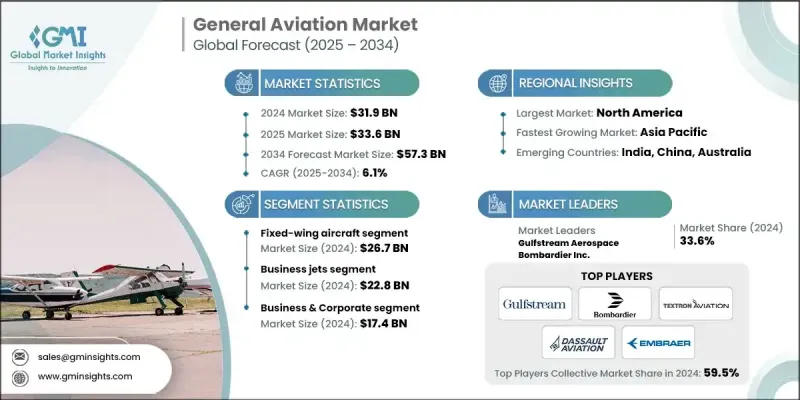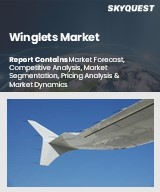
|
시장보고서
상품코드
1833443
일반 항공기 시장 기회, 성장 촉진요인, 산업 동향 분석 및 예측(2025-2034년)General Aviation Market Opportunity, Growth Drivers, Industry Trend Analysis, and Forecast 2025 - 2034 |
||||||
세계의 일반 항공기 시장은 2024년에 319억 달러로 평가되었고, CAGR 6.1%로 성장하여 2034년에는 573억 달러에 이를 것으로 추정되고 있습니다.

이러한 성장을 이끄는 주요 요인으로는 개인 및 레저 항공 수요 증가, 안전 및 항공전자 기술 향상, 비행 훈련 프로그램의 급증, 항공 인프라에 대한 투자 확대 등이 있습니다. 개인 비행 경험과 기업 여행의 편의성에 대한 관심이 높아지면서 시장의 발자취가 확대되고 있습니다. 또한, AI, IoT, 자율 기술을 활용한 스마트 항공 시스템의 도입은 항공 업무를 보다 효율적이고, 안전하고, 예측 가능하게 만들어 상황을 변화시키고 있습니다. 이러한 첨단 시스템은 더 스마트한 설계, 더 나은 진단, 개선된 정비 루틴을 가능하게 합니다. 인프라 업그레이드도 큰 역할을 하고 있으며, 자가용 및 비즈니스 항공기의 접근성 향상과 운영의 용이성을 보장하고 있습니다. 진화하는 기술과 소비자 기대의 융합은 전 세계적으로 일반 항공기 서비스 제공 방식과 지속가능성을 재편하고 있습니다.
| 시장 범위 | |
|---|---|
| 개시 연도 | 2024년 |
| 예측 연도 | 2025-2034년 |
| 시장 규모 | 319억 달러 |
| 예측 금액 | 573억 달러 |
| CAGR | 6.1% |
2024년 고정익 항공기 부문은 267억 달러의 매출을 기록할 것으로 예상되는데, 이는 다목적성, 연료 효율성, 개인용, 비즈니스용, 훈련용 등 다양한 고정익 항공기 모델의 확대에 기인합니다. 기업들은 하이브리드 추진 시스템, 전기 추진 시스템 통합 등 현대 수요에 대응하는 지속 가능하고 다기능적인 항공기 개발에 전략적 초점을 맞추었습니다. 성능, 신뢰성, 환경적 지속가능성을 혁신함으로써, 기업들은 고정익 항공기를 미래의 요구에 더 잘 적응할 수 있는 항공기를 만들고자 합니다.
비즈니스 제트기 부문은 2024년 228억 달러로 평가되었습니다. 기업 지출 증가, 유연하고 시간 효율적인 여행에 대한 수요 증가, 건강 지향적인 여행객들이 개인 항공편을 선택하는 등 이 부문의 성공 요인은 이 부문의 주요 성공 요인으로 꼽히고 있습니다. 각 제조업체들은 강화된 안전 기능, 속도 향상, 운영 비용 효율성, 비행 중 유연성을 제공하는 제트기 개발에 주력하고 있습니다. 고급스러움과 기능성과 비용 및 시간 절약의 균형을 유지하면서 기업 여행에 대한 현대인의 기대에 부응하는 항공기 설계에 중점을 두고 있습니다.
2024년 미국 일반 항공기 시장 규모는 148억 달러에 달할 것으로 예상되며, 조종사 훈련 프로그램 증가, 규제 체계의 변화, 연비 효율과 운항 성능 향상을 위한 기술 혁신이 그 원동력이 될 것으로 보입니다. 미국 기업들은 기술적으로 진보하고 연료를 절약할 수 있는 항공기와 항공전자 시스템 생산에 주력하고 있습니다. 이와 함께 훈련 기준을 업그레이드하고, 국가의 항공 정책 및 운항 기준의 진화에 맞추어 제품 개발을 진행하려는 움직임이 뚜렷해지고 있습니다.
MD Helicopters, Nextant Aerospace, Pilatus Aircraft Ltd., Textron Aviation, Bombardier Inc. Corporation,Airbus,Piper Aircraft, Inc,Cirrus Design Corporation,Epic Aircraft, LLC.,Boeing,Leonardo S.p.A.,Honda Aircraft Company,Piaggio Aerospace S.p.A.,Embraer,Robinson Helicopter Company,Gulfstream Aerospace,Enstrom Helicopter Corporation,Diamond Aircraft Industries,. Dassault Aviation SA. 일반 항공기 시장의 주요 기업들이 채택하고 있는 주요 전략에는 진화하는 환경 기준과 고객 선호에 부응하는 기술적으로 진보하고 에너지 효율적인 항공기를 생산하기 위한 연구개발에 대한 집중적인 노력이 포함됩니다. 기업들은 경쟁력을 유지하기 위해 하이브리드 전기 추진 시스템 및 차세대 항공전자 기술 혁신을 활용하고 있습니다.
목차
제1장 조사 방법과 범위
제2장 주요 요약
제3장 업계 인사이트
- 생태계 분석
- 공급업체 상황
- 이익률
- 비용 구조
- 각 단계에서의 부가가치
- 밸류체인에 영향을 미치는 요인
- 파괴적 변화
- 업계에 대한 영향요인
- 성장 촉진요인
- 개인 및 레저 목적 항공 여행 수요 증가
- 아비오닉스와 안전 시스템 진보
- 파일럿 훈련 프로그램 확대
- 비즈니스 항공과 기업 항공 성장
- 공항 인프라에 대한 투자 증가
- 업계의 잠재적 리스크&과제
- 높은 운영·유지보수 비용
- 엄격한 규제 요건
- 시장 기회
- 첨단디지털 기술과 접속성 통합
- 분할 소유와 리스 모델 확대
- 의료 피난과 구급 서비스 수요 증가
- 온디맨드 항공 모빌리티 서비스 성장
- 성장 촉진요인
- 성장 가능성 분석
- 규제 상황
- 북미
- 유럽
- 아시아태평양
- 라틴아메리카
- 중동 및 아프리카
- Porter의 Five Forces 분석
- PESTEL 분석
- 기술 및 혁신 상황
- 현재 기술 동향
- 신기술
- 가격 동향
- 지역별
- 제품별
- 가격 전략
- 새로운 비즈니스 모델
- 컴플라이언스 요건
- 국방 예산 분석
- 세계의 방위비 동향
- 지역 방위 예산배분
- 북미
- 유럽
- 아시아태평양
- 중동 및 아프리카
- 라틴아메리카
- 주요 방위 현대화 프로그램
- 예산 예측(2025-2034)
- 업계 성장에 대한 영향
- 국가별 방위 예산
- 공급망 회복탄력성
- 지정학적 분석
- 인재 분석
- 디지털 변혁
- 합병, 인수, 전략적 파트너십 상황
- 리스크 평가와 관리
- 주요 계약 체결(2021-2024)
제4장 경쟁 구도
- 서론
- 기업의 시장 점유율 분석
- 지역별
- 북미
- 유럽
- 아시아태평양
- 라틴아메리카
- 중동 및 아프리카
- 시장 집중 분석
- 지역별
- 주요 기업-경쟁 벤치마킹
- 재무 실적 비교
- 매출
- 이익률
- 연구개발
- 제품 포트폴리오 비교
- 제품 라인 업 넓이
- 테크놀러지
- 혁신
- 지역 존재감 비교
- 세계 발자국 분석
- 서비스 네트워크 범위
- 지역별 시장 침투율
- 경쟁 포지셔닝 매트릭스
- 리더들
- 과제자들
- 팔로워
- 니치 기업
- 전략적 전망 매트릭스
- 재무 실적 비교
- 주요 발전, 2021-2024
- 인수합병(M&A)
- 파트너십 및 협업
- 기술적 진보
- 확대와 투자 전략
- 지속가능성 이니셔티브
- 디지털 변혁 대처
- 신규 기업/스타트업 기업 경쟁 구도
제5장 시장 추산·예측 : 기종별, 2021-2034
- 주요 동향
- 비즈니스 제트
- 라이트 제트
- 중형 제트기
- 대형/장거리 제트기
- 터보프롭기
- 단발 엔진
- 다발 엔진
- 피스톤 항공기
- 단발 엔진
- 다발 엔진
- 헬리콥터
제6장 시장 추산·예측 : 유형별, 2021-2034
- 주요 동향
- 고정익 항공기
- 회전익 항공기
제7장 시장 추산·예측 : 최종 용도별, 2021-2034
- 주요 동향
- 프라이빗
- 비즈니스&기업
- 기관
제8장 시장 추산·예측 : 지역별, 2021-2034
- 주요 동향
- 북미
- 미국
- 캐나다
- 유럽
- 독일
- 영국
- 프랑스
- 스페인
- 이탈리아
- 네덜란드
- 아시아태평양
- 중국
- 인도
- 일본
- 호주
- 한국
- 라틴아메리카
- 브라질
- 멕시코
- 아르헨티나
- 중동 및 아프리카
- 사우디아라비아
- 남아프리카공화국
- 아랍에미리트
제9장 기업 개요
- 세계의 주요 기업
- Airbus
- Boeing
- Bombardier Inc.
- Dassault Aviation SA
- Embraer
- 지역별 주요 기업
- 북미
- Cirrus Design Corporation
- Epic Aircraft, LLC.
- Gulfstream Aerospace
- Mooney International Corporation
- Piper Aircraft, Inc.
- Robinson Helicopter Company
- Textron Aviation
- Nextant Aerospace
- 아시아태평양
- Honda Aircraft Company
- 유럽
- Diamond Aircraft Industries
- Leonardo S.p.A.
- Piaggio Aerospace S.p.A.
- Pilatus Aircraft Ltd.
- 북미
- 니치 기업-/디스럽터
- Enstrom Helicopter Corporation
- MD Helicopters
The Global General Aviation Market was valued at USD 31.9 billion in 2024 and is estimated to grow at a CAGR of 6.1% to reach USD 57.3 billion by 2034.

Several key factors are fueling this growth, including rising demand for private and recreational aviation, improvements in safety and avionics technologies, a surge in flight training programs, and greater investments in aviation infrastructure. Increased interest in personal flying experiences and corporate travel convenience is expanding the market footprint. Additionally, the adoption of smart aviation systems using AI, IoT, and autonomous technologies is changing the landscape by making aviation operations more efficient, safe, and predictive. These advanced systems are enabling smarter design, better diagnostics, and improved maintenance routines. Infrastructure upgrades are also playing a major role, ensuring that private and business aircraft have better access and operational ease. The convergence of evolving technology with consumer expectations is reshaping how general aviation services are delivered and sustained globally.
| Market Scope | |
|---|---|
| Start Year | 2024 |
| Forecast Year | 2025-2034 |
| Start Value | $31.9 Billion |
| Forecast Value | $57.3 Billion |
| CAGR | 6.1% |
In 2024, the fixed-wing aircraft segment generated USD 26.7 billion, attributed to the versatility, fuel efficiency, and expanding fleet of fixed-wing models across private, business, and training applications. Companies are placing strategic emphasis on developing sustainable and multi-functional aircraft that meet modern demands, including the integration of hybrid and electric propulsion systems. By innovating for performance, reliability, and environmental sustainability, businesses are aiming to make fixed-wing aviation more adaptable to future needs.
The business jet segment was valued at USD 22.8 billion in 2024. Increased corporate expenditure, growing demand for flexible and time-efficient travel, and health-conscious travelers opting for private flights are key contributors to this segment's success. Manufacturers are channeling efforts into creating jets that offer enhanced safety features, improved speed, operational cost-efficiency, and greater in-flight flexibility. Emphasis is being placed on aircraft designs that fulfill modern expectations of corporate travel, balancing luxury and function with cost and time savings.
United States General Aviation Market was valued at USD 14.8 billion in 2024, driven by a rise in pilot training programs, shifts in regulatory frameworks, and innovations aimed at boosting fuel efficiency and operational performance. Companies in the U.S. are focusing on producing technologically advanced, fuel-conscious aircraft and avionics systems. Alongside, there is a clear push to upgrade training standards and align product development with the evolving aviation policies and operational standards in the country.
Prominent players contributing to the General Aviation Market include MD Helicopters, Nextant Aerospace, Pilatus Aircraft Ltd., Textron Aviation, Bombardier Inc., Mooney International Corporation, Airbus, Piper Aircraft, Inc., Cirrus Design Corporation, Epic Aircraft, LLC., Boeing, Leonardo S.p.A., Honda Aircraft Company, Piaggio Aerospace S.p.A., Embraer, Robinson Helicopter Company, Gulfstream Aerospace, Enstrom Helicopter Corporation, Diamond Aircraft Industries, and Dassault Aviation SA. Key strategies adopted by leading companies in the general aviation market include a strong focus on R&D to produce technologically advanced, energy-efficient aircraft that meet evolving environmental standards and customer preferences. Firms are leveraging innovation in hybrid-electric propulsion systems and next-gen avionics to stay competitive.
Table of Contents
Chapter 1 Methodology and Scope
- 1.1 Market scope and definition
- 1.2 Research design
- 1.2.1 Research approach
- 1.2.2 Data collection methods
- 1.3 Data mining sources
- 1.3.1 Global
- 1.3.2 Regional/Country
- 1.4 Base estimates and calculations
- 1.4.1 Base year calculation
- 1.4.2 Key trends for market estimation
- 1.5 Primary research and validation
- 1.5.1 Primary sources
- 1.6 Forecast model
- 1.7 Research assumptions and limitations
Chapter 2 Executive Summary
- 2.1 Industry snapshot
- 2.2 Key market trends
- 2.2.1 Aircraft type trends
- 2.2.2 Type trends
- 2.2.3 End use trends
- 2.2.4 Regional
- 2.3 TAM Analysis, 2025-2034 (USD Billion)
- 2.4 CXO perspectives: Strategic imperatives
- 2.4.1 Executive decision points
- 2.4.2 critical success factors
- 2.5 Future outlook and strategic recommendations
Chapter 3 Industry Insights
- 3.1 Industry ecosystem analysis
- 3.1.1 Supplier Landscape
- 3.1.2 Profit Margin
- 3.1.3 Cost structure
- 3.1.4 Value addition at each stage
- 3.1.5 Factor affecting the value chain
- 3.1.6 Disruptions
- 3.2 Industry impact forces
- 3.2.1 Growth drivers
- 3.2.1.1 Increasing demand for personal and recreational air travel
- 3.2.1.2 Advancements in avionics and safety systems
- 3.2.1.3 Expansion of pilot training programs
- 3.2.1.4 Growth in business and corporate aviation
- 3.2.1.5 Rising investments in airport infrastructure
- 3.2.2 Industry pitfalls and challenges
- 3.2.2.1 High operational and maintenance costs
- 3.2.2.2 Stringent regulatory requirements
- 3.2.3 Market opportunities
- 3.2.3.1 Integration of advanced digital technologies and connectivity
- 3.2.3.2 Expansion of fractional ownership and leasing models
- 3.2.3.3 Increasing demand for medical evacuation and emergency services
- 3.2.3.4 Growth of on-demand air mobility services
- 3.2.1 Growth drivers
- 3.3 Growth potential analysis
- 3.4 Regulatory landscape
- 3.4.1 North America
- 3.4.2 Europe
- 3.4.3 Asia Pacific
- 3.4.4 Latin America
- 3.4.5 Middle East & Africa
- 3.5 Porter’s analysis
- 3.6 PESTEL analysis
- 3.7 Technology and innovation landscape
- 3.7.1 Current technological trends
- 3.7.2 Emerging technologies
- 3.8 Price trends
- 3.8.1 By region
- 3.8.2 By product
- 3.9 Pricing strategies
- 3.10 Emerging business models
- 3.11 Compliance requirements
- 3.12 Defense budget analysis
- 3.13 Global defense spending trends
- 3.14 Regional defense budget allocation
- 3.14.1 North America
- 3.14.2 Europe
- 3.14.3 Asia Pacific
- 3.14.4 Middle East and Africa
- 3.14.5 Latin America
- 3.15 Key defense modernization programs
- 3.16 Budget forecast (2025-2034)
- 3.16.1 Impact on Industry Growth
- 3.16.2 Defense Budgets by Country
- 3.17 Supply chain resilience
- 3.18 Geopolitical analysis
- 3.19 Workforce analysis
- 3.20 Digital transformation
- 3.21 Mergers, acquisitions, and strategic partnerships landscape
- 3.22 Risk assessment and management
- 3.23 Major contract awards (2021-2024)
Chapter 4 Competitive Landscape, 2024
- 4.1 Introduction
- 4.2 Company market share analysis
- 4.2.1 By region
- 4.2.1.1 North America
- 4.2.1.2 Europe
- 4.2.1.3 Asia Pacific
- 4.2.1.4 Latin America
- 4.2.1.5 Middle East & Africa
- 4.2.2 Market Concentration Analysis
- 4.2.1 By region
- 4.3 Competitive benchmarking of key players
- 4.3.1 Financial performance comparison
- 4.3.1.1 Revenue
- 4.3.1.2 Profit margin
- 4.3.1.3 R&D
- 4.3.2 Product portfolio comparison
- 4.3.2.1 Product range breadth
- 4.3.2.2 Technology
- 4.3.2.3 Innovation
- 4.3.3 Geographic presence comparison
- 4.3.3.1 Global footprint analysis
- 4.3.3.2 Service network coverage
- 4.3.3.3 Market penetration by region
- 4.3.4 Competitive positioning matrix
- 4.3.4.1 Leaders
- 4.3.4.2 Challengers
- 4.3.4.3 Followers
- 4.3.4.4 Niche players
- 4.3.5 Strategic outlook matrix
- 4.3.1 Financial performance comparison
- 4.4 Key developments, 2021-2024
- 4.4.1 Mergers and acquisitions
- 4.4.2 Partnerships and collaborations
- 4.4.3 Technological advancements
- 4.4.4 Expansion and investment strategies
- 4.4.5 Sustainability initiatives
- 4.4.6 Digital transformation initiatives
- 4.5 Emerging/ startup competitors landscape
Chapter 5 Market Estimates and Forecast, By Aircraft Type, 2021 - 2034 (USD Million & Units)
- 5.1 Key trends
- 5.2 Business jets
- 5.2.1 Light jets
- 5.2.2 Midsize jets
- 5.2.3 Large/long-range jets
- 5.3 Turboprops
- 5.3.1 Single-engine
- 5.3.2 Multi-engine
- 5.4 Piston aircraft
- 5.4.1 Single-engine
- 5.4.2 Multi-engine
- 5.5 Helicopters
Chapter 6 Market Estimates and Forecast, By Type, 2021 - 2034 (USD Million & Units)
- 6.1 Key trends
- 6.2 Fixed-Wing Aircraft
- 6.3 Rotary-Wing Aircraft
Chapter 7 Market Estimates and Forecast, By End Use, 2021 - 2034 (USD Million & Units)
- 7.1 Key trends
- 7.2 Private
- 7.3 Business & Corporate
- 7.4 Institutional
Chapter 8 Market Estimates and Forecast, By Region, 2021 - 2034 (USD Million & Units)
- 8.1 Key trends
- 8.2 North America
- 8.2.1 U.S.
- 8.2.2 Canada
- 8.3 Europe
- 8.3.1 Germany
- 8.3.2 UK
- 8.3.3 France
- 8.3.4 Spain
- 8.3.5 Italy
- 8.3.6 Netherlands
- 8.4 Asia Pacific
- 8.4.1 China
- 8.4.2 India
- 8.4.3 Japan
- 8.4.4 Australia
- 8.4.5 South Korea
- 8.5 Latin America
- 8.5.1 Brazil
- 8.5.2 Mexico
- 8.5.3 Argentina
- 8.6 Middle East and Africa
- 8.6.1 Saudi Arabia
- 8.6.2 South Africa
- 8.6.3 UAE
Chapter 9 Company Profiles
- 9.1 Global Key Players
- 9.1.1 Airbus
- 9.1.2 Boeing
- 9.1.3 Bombardier Inc.
- 9.1.4 Dassault Aviation SA
- 9.1.5 Embraer
- 9.2 Regional key players
- 9.2.1 North America
- 9.2.1.1 Cirrus Design Corporation
- 9.2.1.2 Epic Aircraft, LLC.
- 9.2.1.3 Gulfstream Aerospace
- 9.2.1.4 Mooney International Corporation
- 9.2.1.5 Piper Aircraft, Inc.
- 9.2.1.6 Robinson Helicopter Company
- 9.2.1.7 Textron Aviation
- 9.2.1.8 Nextant Aerospace
- 9.2.2 Asia Pacific
- 9.2.2.1 Honda Aircraft Company
- 9.2.3 Europe
- 9.2.3.1 Diamond Aircraft Industries
- 9.2.3.2 Leonardo S.p.A.
- 9.2.3.3 Piaggio Aerospace S.p.A.
- 9.2.3.4 Pilatus Aircraft Ltd.
- 9.2.1 North America
- 9.3 Niche Players/ Disruptors
- 9.3.1.1 Enstrom Helicopter Corporation
- 9.3.1.2 MD Helicopters



















